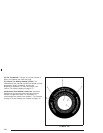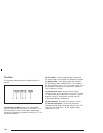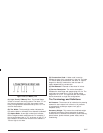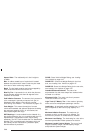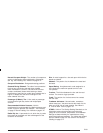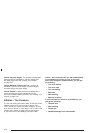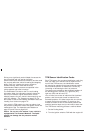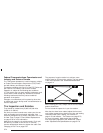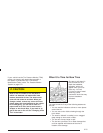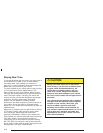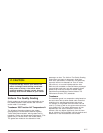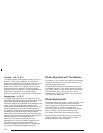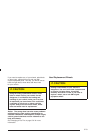
Driving on a significantly under-inflated tire causes the
tire to overheat and can lead to tire failure.
Under-inflation also reduces fuel efficiency and tire tread
life, and may affect the vehicle’s handling and stopping
ability. Each tire, including the spare, should be
checked monthly when cold and set to the
recommended inflation pressure as specified in the
vehicle placard and owner’s manual.
The Certification/Tire label or the Tire and Loading
Information label (tire information placard) shows the
size of your vehicle’s original tires and the correct
inflation pressure for your vehicle’s tires when they are
cold. See Inflation - Tire Pressure on page 5-70. For
the location of the tire and loading information label, see
Loading Your Vehicle on page 4-47.
Your vehicle’s TPM system can alert you about a low
tire pressure condition but it does not replace normal tire
maintenance. See Tire Inspection and Rotation on
page 5-74 and Tires on page 5-62.
Notice: Do not use a tire sealant if your vehicle is
equipped with Tire Pressure Monitors. The liquid
sealant can damage the tire pressure monitor
sensors.
TPM Sensor Identification Codes
Each TPM sensor has a unique identification code. Any
time you rotate your vehicle’s tires or replace one or
more of the TPM sensors, the identification codes
will need to be matched to the new tire/wheel position.
Each tire/wheel position is matched to a sensor, by
increasing or decreasing the tire’s air pressure.
The sensors are matched to the tire/wheel positions in
the following order: left front (LF); right front (RF);
right rear (RR) and left rear (LR).
You will have one minute to match the first tire/wheel
position, and five minutes overall to match all four
tire/wheel positions. If it takes longer than one minute,
to match the first tire and wheel, or more than five
minutes to match all four tire and wheel positions the
matching process stops and you will need to start over.
The TPM sensor matching process is outlined below:
1. Set the Parking brake.
2. Turn the ignition switch to RUN with the engine off.
5-72



